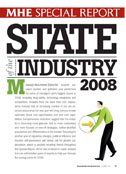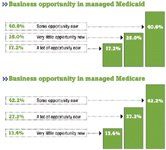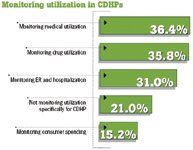State of the Industry 2008
Managed Healthcare Executive recently surveyed readers and gathered your predictions for some of managed care's biggest issues in 2008, including drug safety, technology integration and competition. Answers from the more than 500 respondents indicate that an increasing number of you are uncertain about what the next year will bring, but you remain optimistic about your opportunities and your core capabilities. Comprehensive indicators suggest that the industry is becoming more granular, that is, more customized and more focused on one-off strategies, further stratified populations and differentiation in the market. Preparing for another year of regulatory changes, political influence and industry self-governance will clearly call for greater collaboration, which is another recurring theme throughout this Special Report. We've also included in-depth analysis from an authoritative panel of experts to help you forecast the turning points for 2008.


ALTHOUGH POLICY MAKERS continue to reshape Medicare and Medicaid with varying effects on payers and providers, some in the industry believe the market still holds opportunity. Don Hall, principal, Delta Sigma LLC, a Colorado consulting firm, says he's surprised by that optimism.

"Medicaid is a program that has in many ways reached its maturity, and there's not a lot of new markets left, the exception being South Carolina, which put a lot more people in managed Medicaid, and Colorado will potentially put all their people into managed Medicaid as well," he says. "With state budgets the way they are, and the federal government's budget the way it is, I actually think [these results are] more optimistic than I might have guessed, because there just isn't a lot left in that market right now."
Yet, there are other compelling influences that make the market attractive in its own right. Serving underserved populations and contributing to a local community has become part of the mission for many MCOs.
SPECIALTY SEGMENT
Daniel J. Hilferty, president and CEO of AmeriHealth Mercy, a managed Medicaid plan, says he believes that there are more opportunities than some might think.
"Those of us in the industry realize that Medicaid and Medicare managed care is a specialty, and it takes commitment and special expertise to do it well," Hilferty says. "If you have the experience and the interest, it is easier to see the opportunities in what can be a challenging, yet very satisfying business. The satisfaction in Medicaid managed care comes from its ability to increase access and improve quality of healthcare for underserved populations."
MEDICARE SPENDING
Hall says spending cutbacks in Medicare are frequently discussed in Congress, and it's making MCOs nervous about the possibility of lower rates, which could drive them away from the market, similar to the situation that occurred with Medicare + Choice.
However, the current trend of Medicare Advantage plans shows significant growth in the past year. There are 604 MA contracts nationwide and more than 8.3 million seniors enrolled.
"We are probably in one of the most uncertain periods in healthcare that we've been in perhaps since the late 1980s," Hall says. "Nobody knows what's going to happen in Washington, and clearly Medicare and Medicaid would be dramatically impacted by anything that does happen there."
Strong state-led programs and pilots seem to have the most potential to maintain coverage for the high-risk, underserved populations and the uninsured. Efforts are incremental and in many cases aim to increase funding received by the states, he says. At least 30 states have proposals on the table to increase coverage, including a variety of disease management and other programs.
NEXT YEAR
"Healthcare consistently polls as a top domestic concern for voters, and we can all look forward to a spirited debate on the issues during the year," Hilferty says. "Otherwise, we do not expect major changes in the programs, and believe that any Medicaid reform will continue to take place at the state level in 2008."
Other opportunities further into the future might include managed Medicaid for long-term care, according to Hall. He says that's where the bulk of the costs are associated.
"It's truly been the sacred cow from a managed care standpoint, where states don't want to let organizations manage that," Hall says. "The crisis in healthcare may change that. In 2008, we might see some states really open it up. If that happens, it would have an enormous impact on managed care companies because that's really where the dollars are. There's a lot of things that can be done to save money in that area."
THE ADOPTION OF consumer-directed health plans (CDHPs) is expected to rise in 2008, taking a small bite out of enrollment in point-of-service plans and HMOs. Last year, adoption was less than 4% overall among covered workers. When MHE asked readers if they monitored utilization in their CDHPs, as many as 21.0% indicated they do not.

The 2006 Mercer Survey of Employer-sponsored Health Plans estimates that 14% of small employers were likely to offer a CDHP in 2007, jumping to 16% in 2008. Large employers will bump their 2007 position at 14% to 19% next year, while new adoption by very large employers, the first to offer CDHPs, will be modest.
COOLING OFF PERIOD
Mercer conducted a meta-comparison, which indicated that for employees in CDHPs, preventive care visits increased and office visits remained about the same, while ER visits and hospital admittances per 1,000 people decreased-the latter of which is expected to moderate or rise. In addition, the use of generics increased, while prescriptions per person fell.
Although Tracy Watts, principal, Mercer Health and Benefits Consulting in Washington, D.C., predicts that the CDHP marketplace will cool off for the next two years, she sees a shift from PPOs and health reimbursement accounts (HRAs) to health savings accounts (HSAs).
"The change can be attributed to some employers who have already piloted an HSA and now want to expand the concept, those that have waited to see how the accounts will pan out, and other employers who were dissatisfied with their current options," she says.
Even those employers who are not yet ready to adopt high deductibles and savings accounts are introducing consumer-directed strategies, such as health-risk assessments, wellness programs and more cost-sharing, she says.
Carl Doty, a senior analyst with Forrester Research in Boston agrees with Watts that HSAs have surpassed HRAs and that the gap is widening. The increase in individual and family contributions-up from $2,600 to $2,700 and $5,150 to $5,450, respectively in 2006-should engage more consumers and promote a "savings" approach. Healthcare benefits consultants who were recently queried predict an increase of about 4 million HSAs, putting the total at about 10 million.
Calling CDHPs "the best savings vehicles since 401(k) options became available," Doty estimates that the plans are on pace to capture one-third or at least one-fourth of the market by 2012; he estimates enrollment in a high-deductible plan to be 6%, and 5% for those who have a savings account attached. However, he sees the lack of customer service as a sticking point in the growth of CDHPs, as well as a lack of awareness of the options.
"If customer service is not addressed and engagement tools are unavailable, the growth trend will slow," he adds.
CDHP APPEAL
Doty anticipates that CDHPs will become more attractive to the individual market with several large insurers offering an array of products.
Mark Olson, a healthcare actuary and principal with Towers Perrin in Boston, believes that part of the success of CDHPs rests on employer efforts to proactively encourage more enrollment.
"Employers should promote CDHPs as an opportunity for employees to save money for healthcare at retirement," he adds.
Extending the Capabilities of the EHR Through Automation
August 2nd 2023Welcome back to another episode of "Tuning In to the C-Suite," where Briana Contreras, an editor of Managed Healthcare Executive, had the pleasure of chatting with Cindy Gaines, chief clinical transformation officer at Lumeon.
Listen
Automate Your Practice's Workflows with These 5 Tools
October 4th 2023To maintain patient satisfaction and regulatory compliance and reduce potential clerical errors while maintaining high productivity, you can ease your staff’s burdens by automating your practice’s workflows and empower your staff to do more in less time.
Read More